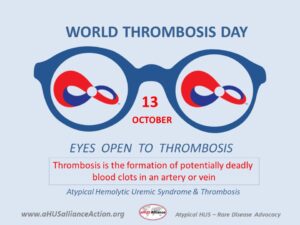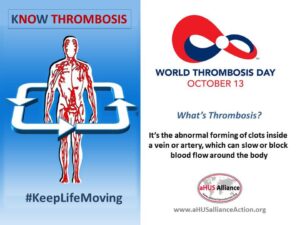Article No. 386
10 October 2020

Every year on October 13th people and groups around the world mark ‘World Thrombosis Day’, a day set aside to raise awareness of how clot formation in veins or arteries (thrombosis) can be life threatening. No matter the patient’s age or race, clots such as these can occur in organs and locations throughout the body and often have devastating consequences.
We all need to keep a watchful eye out for thrombosis, especially if you have risk factors for clot formation. That’s true for people who have been diagnosed with atypical HUS, and why aHUS Global Action advocates are helping to raise blood clot awareness for World Thrombosis Day.
We all need to keep our ‘Eyes Open to Thrombosis’, the 2020 campaign for World Thrombosis Day.
Why people with aHUS need to know about blood clots
People with the very rare disease atypical haemolytic uraemic syndrome (aHUS, or atypical HUS) experience the formation of tiny clots in their small blood vessels which can cause damage to vital organs such as the kidneys, heart, GI tracts, or elsewhere. During periods of aHUS activity, the lining of small blood vessels rises up to shear apart and destroy red blood cells (hemolysis). Damage to blood vessels causes the body to send platelets to that site, where they form a clot (or thrombus) to stop bleeding.
Atypical HUS is one of the medical diagnoses which is a form of thrombotic microangiopathy (TMA), the term for tiny clot formation which blocks small blood vessels and causes damage. People with aHUS usually experience kidney damage which the disease name itself specifies, as a ‘uremic syndrome’. Atypical HUS activity triggers lower than normal lab values for both red blood cell and platelet counts (due to hemolysis, and to thrombi or multiple small clot formation). World Thrombosis Day is an opportunity for people to become better informed about causes and risk factors for blood clot formation, and for advocacy groups to raise awareness of how this can affect overall health.
Thrombosis: Types, Risks & Signs of clot formation
There are two broad classifications of thrombosis, categorized by whether the blood clot forms in a vein or in an artery. When clotting occurs in a vein it’s called venous thromboembolism or VTE, with clots in deep veins most usually in the legs and known as ‘deep vein thrombosis’ or DVT. Clumps of these clots (thrombosis) can break off and travel elsewhere in the body, leaving a clot circulating within the bloodstream and then lodged in the lungs, known as a ‘pulmonary embolism’ (clot blocking a lung artery) or PE.
Signs of clot formation may include pain in the affected leg or arm, and tenderness or swelling. Since clots can form anywhere in the body, people instead may have no distinct symptoms but experience issues related to organ damage when clotting affects blood flow in a particular area of the body.
Risk factors for blood clot formation include prolonged inactivity, obesity, injury to veins or tissues, smoking, oral contraceptives, pregnancy, and certain cancers and diseases. Some risks may be inherited, but others are acquired and can be influenced by lifestyle factors. One risk factor of particular concern to those with atypical HUS is the genetic tendency toward blood clots. Talk with your doctor if you have multiple thrombosis risk factors, such a diagnosis of a disease which includes a tendency toward blood clot formation and also smoke, are pregnant, or have additional risk factors.
‘Know Thrombosis’, and what you and your doctors can do to monitor or reduce your risk of thrombosis.
Know Thrombosis if You’re Diagnosed with aHUS
It’s important to keep your ‘Eyes Open to Thrombosis’’, including what people can do to reduce the risk of thrombosis. People with blood-related illness often are referred to a hematologist for diagnosis and treatment, a source of information for many with aHUS. The World Thrombosis Day (WTD) website offers a vast array of information about thrombosis in general, and we’ve listed additional resources of high interest to the aHUS community.
Atypical HUS symptoms can be vague in nature, to include fatigue which can accompany low red blood cell counts (anemia) or bruising easily due to low platelet counts (thrombocytopenia) when platelets are involved with clot formation. While a very rare disease, aHUS is difficult to diagnose and impacts people with a wide range of symptoms, severity, organs affected, and duration of aHUS disease activity. If clot formation occurs in the heart or brain, atypical HUS activity can cause life-threatening issues such as seizures, strokes, or heart attacks. The aHUS Alliance website’s Atypical HUS Resource Page not only includes disease-specific information, but also a vast array of original content on why blood clots are of key concern to aHUS patients and those who treat them.
Some FAQs about World Thrombosis Day, from the WTD website
Why is World Thrombosis Day held each 13 October?
“WTD takes place every year on 13 October, the birthday of Rudolf Virchow who was a pioneer in the pathophysiology of thrombosis. A German physician, pathologist, biologist and anthropologist, Virchow developed the concept of “thrombosis” and advanced our understanding of this condition”
Why hold a World Thrombosis Day, and what are its goals?
“WTD seeks to increase global awareness of thrombosis, including its causes, risk factors, signs/symptoms and evidence-based prevention and treatment. Ultimately, we strive to reduce death and disability caused by the condition.” and to “highlight the burden of disease (thrombosis in general) and highlight the need for action, specifically underscoring the unrecognized threat and serious consequences (morbidity and mortality) related to venous thromboembolism (VTE) and atrial fibrillation (AFib).”
See other info about WTD on their FAQ page
aHUS & Clots that Block Tiny Blood Vessels (microvascular thrombosis)
Atypical HUS is one of a related group of syndromes, called thrombotic microangiopathies (TMA) which have similar and overlapping clinical features which includes small clots which cause anemia, low platelet counts and injury to the kidneys and other organs. It’s sometimes called ‘familial HUS’ since complement mutations which cause uncontrolled activation of part of the body’s immune system can be genetically linked within families.
Learn More about Thrombosis
Atypical HUS, TMA, and Complement
Understanding Thrombosis – WTD
Information & Assets from the World Thrombosis Day website
aHUS Alliance – Video, presentation by Dr Nathan T. Connell
aHUS as a TMA: A Hematologist’s Perspective
Global aHUS advocates partnered with Boston area physicians to the MedEd event #TMABoston: “Thrombotic Microangiopathy: Through the Lens of aHUS”
Thrombosis UK – Video, presented by Dr Kate Bramham
aHUS and Pregnancy
Thrombosis UK – Video, presented by Prof David Kavanagh
Pregnancy-associated aHUS from National aHUS Service
ASH: American Society of Hematology – Info for Patients
ASH: Patient Info about Clots
aHUS Alliance – Info & Resources
Research & Publications Page
Research listed by Topics, to include Diagnosis, TMA, Complement, Pregnancy, Organs Affected (Extra-Renal) & More
Atypical HUS Resources
Articles & Assets focused on Atypical HUS, related to TMA, Complement and More
aHUS: A Quick-Start Introduction & Resource List
Atypical HUS 1.0
aHUS & World Thrombosis Day – aHUS Alliance Article
Activities and Information of interest to the aHUS community, from WTD 2017


